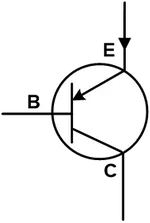Introduction of BJT Amplifier Calculator
This BJT Amplifieronline calculator calculates bias voltages and currents, gains, and frequency responses for the Cascode amplifier.
The Cascode amplifier has high gains and wide bandwidths. By using a second transistor as a common-base current buffer, the common emitter amplifier is able to overcome Miller's capacitance limitations. Due to this, it is capable of generating gain bandwidth orders of magnitude larger than that of common emitter amplifiers. A second transistor is required, along with an additional voltage supply to allow for decent operating margins for the transistors.
A cascode gain of RC/RE2 controls the gain for this cascode. A higher sum of RE1 and RE2 represents greater bandwidth.
To prevent overloading of the output stage and reduced frequency response, a second emitter follower buffer stage is essential for frequencies above 2MHz in the real world. If you use a 1MHz scope probe for this amplifier, the capacitance will roll off the frequency at 2 MHz. The frequency response should be measured through a buffer on a scope.
Introduction of Cascode Amplifier
What is Cascode Amplifier?
The Cascode Amplifier is the combination of the Common Source and the Common gate stages. And the common source is comm Emitter for BJT. The Common Gate Stage presents the Common Base for BJT. The following picture shows you the common source amplifier applied with the input.

Advantage and Disadvantage of Cascode Amplifier
The following is the advantages of the cascode amplifier:
Cascode circuit gives elevated advantage, stability, more suitable impedance levels, extra bandwidth levels, and slew rate.
The production of the circuit is so simple.
The bandwidth is excessive because of the removal of the Miller Effect.
Cascode amplifier is carried out as a multiplying mixer with-inside the superheterodyne receivers. For the higher gate, the mixer is fed with the oscillator signal, and the decrease gate s fed via way of means of RF signal. Then each those alerts are improved and the IF is taken into consideration because the higher drain of the mixer-amplifier.
Even the elements of the depend for each the transistors are low.
Due to the cascode connection among transistors the general advantage of the device is excessive.
The below lists the disadvantages of these amplifiers are:
The presence of transistors calls for a excessive quantity of voltage deliver. The enough quantity of drain to supply voltage have to be furnished to each the transistor which moves lesser the restriction at the deliver voltage.
Applications of Cascode Amplifier
The applications of these amplifiers are:
Cascode amplifiers are used in the RF tuners. And Amplitude modulation technique uses cascoding technique.
Simple Introduction to Bipolar Junction Transistors (BJT)
A Bipolar Junction Transistor is a solid-nation tool wherein the modern go with the drift among terminals (the collector and the emitter) is managed through the quantity of modern that flows thru a 3rd terminal (the base).
A Bipolar Junction Transistor may be used for analog circuits, mainly for very-high-frequency applications, which include radio-frequency circuits for Wi-Fi systems. Bipolar transistors may be blended with MOSFETs in an incorporated circuit through the usage of a BiCMOS manner to create progressive circuits that take benefit of the quality traits of each kinds of transistor.
The invention of the bipolar transistor in 1948 ushered in a revolution in electronics. Technical feats formerly requiring highly large, robotically fragile, power-hungry vacuum tubes have been unexpectedly manageable with tiny, robotically rugged, power-thrifty specks of crystalline silicon. This revolution made viable the layout and manufacture of lightweight, less expensive digital gadgets that we now take for granted. Understanding how transistors feature is of paramount significance to all people inquisitive about information present day electronics.
A Bipolar Junction Transistor (BJT) become invented in December 1947 on the Bell Telephone Laboratories through John Bardeen and Walter Brattain beneathneath the course of William Shockley.
The Function and Applications for Bipolar Junction Transistors
My intent here is to focus as exclusively as possible on the practical function and application of bipolar transistors, rather than to explore the quantum world of semiconductor theory. Discussions of holes and electrons are better left to another chapter in my opinion. Here I want to explore how to use these components, not analyze their intimate internal details. I don’t mean to downplay the importance of understanding semiconductor physics, but sometimes an intense focus on solid-state physics detracts from understanding these devices’ functions on a component level. In taking this approach, however, I assume that the reader possesses a certain minimum knowledge of semiconductors: the difference between “P” and “N” doped semiconductors, the functional characteristics of a PN (diode) junction, and the meanings of the terms “reverse biased” and “forward biased.” If these concepts are unclear to you, it is best to refer to earlier chapters in this book before proceeding with this one.
BJT Layers
A bipolar transistor includes a three-layer “sandwich” of doped (extrinsic) semiconductor materials, (a and c) both P-N-P or N-P-N (b and c ). Each layer forming the transistor has a particular name, and every layer is supplied with a cord touch for connection to a circuit. The schematic symbols are proven withinside the figure (a) and (c).
BJT transistor: (a) PNP schematic symbol, (b) layout (c) NPN schematic symbol, (d) layout.
The practical distinction among a PNP transistor and an NPN transistor is the right biasing (polarity) of the junctions whilst operating.
Bipolar transistors paintings as cutting-edge-managed cutting-edge regulators. In different words, transistors limition the quantity of cutting-edge exceeded consistent with a smaller, controlling cutting-edge. The major cutting-edge this is managed is going from collector to emitter, or from emitter to collector, relying at the kind of transistor it is (NPN or PNP, respectively). The small cutting-edge that controls the principle cutting-edge is going from base to emitter, or from emitter to base, all over again relying at the type of transistor it is (NPN or PNP, respectively). According to the requirements of semiconductor symbology, the arrow constantly factors withinside the course of cutting-edge flow.
The course of the small, controlling cutting-edge and the big managed cutting-edge for (a) a PNP and (b) an NPN transistor.
2 Types of Bipolar Transistors
A bipolar transistor is also named bipolar junction transistor, which shorts for BJT. There are 2 types of semiconductor material for the main flow of current through the transistors. So a bipolar transistor has two types of structure: a PNP(Positive-Negative-Positive) type and a NPN(Negative-Positive-Negative) type. Therefore, you often heard someone asked what is the difference between NPN transistor and PNP transistor. Generally the current of a PNP is up to -600V, but a NPN is available for up to 800V. Moreover, there is another type of transistors, named BRTs (bias resistor built-in transistors).
NPN vs PNP Transistor
The following table will show you the main differences between NPN and PNP.
PNP Transistor | NPN Transistor | |
Collector-emitter voltage | Negative | Positive |
Structure | It has one N-type and two P-type semiconductors. | It has two N-type and one P-type semiconductor. |
Minority charge carrier | Electrons | Holes |
Junction biasing | Emitter-base junction is in reverse bias and collector-base junction is in forward bias. | Emitter-base junction is in forward bias and collector-base junction is in reverse bias. |
Direction of current | The current will flow through the emitter to the collector. | The current will flow through the collector to the emitter. |
Majority charge carrier | Holes | Electron |
Emitter arrow | Pointed in | Pointed out |
Switching time | Slower | Faster |
Symbol |
|
|
























